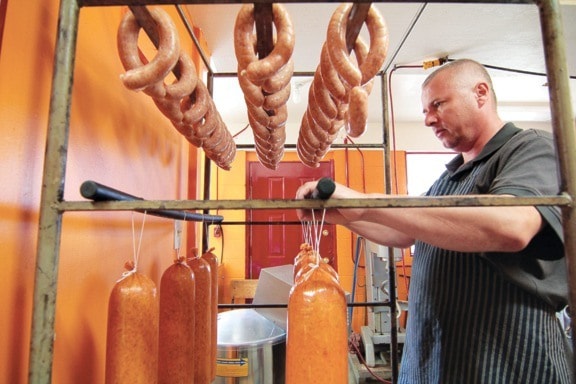Catherine Davies and Pawel Biegun, owners of Nanaimo Sausage House, produce about 60 different recipes at any one time in their shop on Ross Road.
Neither of them set out planning to make sausage for a living.
Biegun had left the forest industry and just finished two years of business and accounting courses. A friend was selling the business, the price was right and Davies and Biegun liked the products.
Biegun always wanted to run his own business, perhaps a marina, since his passion is sailing.
“I had no dreams from childhood to be a sausage-maker,” Biegun said.
Sausage is one of the oldest ways to preserve meat and dates back about 3,000 years.
Sausage is made from ground meat stuffed in an intestine liner. The meat is cooked or cured, hung to dry and smoked to preserve it.
Often made from ground and spiced leftovers from butchering, sausage was a way of ensuring nothing from an animal was wasted. Smoking was often done at homes and farms.
Biegun said people would even smoke sausage in outhouses temporarily removed from latrine holes.
Others would smoke sausages in chambers built into their homes’ chimneys.
Sausage and other smoked meats travel well and stay fresh over long periods in a wide range of temperatures and climates.
Preparing and packing sausage involves long hours of hard physical work.
“It’s a love/hate relationship,” Biegun said. “It’s something that definitely makes us proud of our work. At the same time that’s exactly what it is – work and work and work.”
Now in their early 40s, Davies’s and Biegun’s business partnership has outlasted their personal relationship.
“We have children together, but we’ve been split up for six or seven years now and continue to run the business together,” Davies said. “We’ve managed to make it work.”
Together they carved out a small niche market in Nanaimo with a following of customers who appreciate and are willing to pay the premium for quality.
Biegun said Nanaimo Sausage House charges about 30 per cent more for its products than mass marketers, but their sausages are made with prime cut meats, have no fillers, such as bread, soy, wheat or gluten – often added as inexpensive bulking agents – and preservatives can be kept to a minimum thanks to modern technology.
“Right now we have great control over the production,” Biegun said. “We have thermometers and all the electronic temperature control systems ... therefore we can very safely make these products without using nitrates.”
Still, some people prefer the pink colour nitrates create in the meat.
But there is no magic recipe or carefully guarded trade secret behind producing superior sausage.
“There’s just one secret – and that’s a lot of hard work,” Biegun said. “The amount of work and passion you put into the process, some of the ingredients that you use and the quality of processing and that’s what I see as the only real trade secret.”
photos@nanaimobulletin.com
